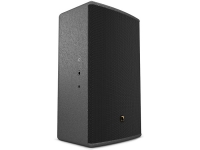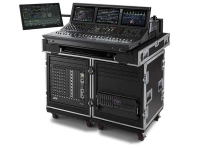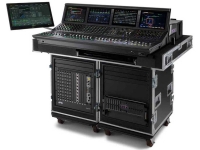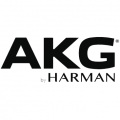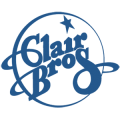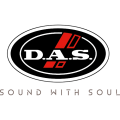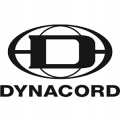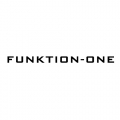ABOUT THE PRODUCT
ABOUT THE MANUFACTURER
GLOSSARY
X8
Live Monitor Enclosure
X8 is the ideal live monitor, with the capacity to accurately translate the sonic signature of a large sound system at FOH or in control rooms. The X8 boasts high SPL and extended LF resources in a compact format carrying the pristine L-Acoustics sonic signature. The point source wide, conical directivity pattern imparts excellent spatialization and no minimum listening distance, assuring a flawless listening experience when monitoring sound.
The X8 can also be rigged in a diverse array of configurations, including pole-mounted or wall- and ceiling- mounted or flown. Configurations are quick and easy, with the complete range of rigging accessories offered. Whether using X8 as a monitor, or as an integral part of a larger PA system, the X8 will be appreciated for its power, broad bandwidth and immaculate sound.
- Pristine sound quality, L-Acoustics sonic signature
- SPL and LF resources at FOH position or control rooms
- Extended bandwidth in a compact format
- Wide conical directivity pattern for spatialization
- No minimum listening distance
Professional used lighting equipment.| Professional second hand lighting equipment.| Professional pre owned lighting equipment.
Professional used audio equipment.| Professional second hand audio equipment.| Professional pre owned audio equipment.
Second hand audio gear. | Second hand lighting.
Pro audio equipment, second hand amplifiers, DJ, second hand sound systems, second hand Microphones, second hand Media Players.
Outdoor & Indoor LED screens for sale, LED mobile truck.
Light trussing, Gebrauchte Veranstaltungstechnik, used stage equipment Stage & Theatre lighting products.
Used L-Acoustics
L-Acoustics is a French manufacturer of loudspeakers, amplifiers and signal processing devices for rental and installed sound markets. Headquartered in Marcoussis, just south of Paris, the company has satellite operations in the United States, United Kingdom and Germany, as well as a global Rental Network of production companies deploying and cross-renting its products. The company is also known for providing music festivals with its loud, powerful sounding speakers.In September 1984, Dr. Christian Heil, a physicist in the field of elementary particles with a passion for sound, created an electro-acoustic engineering firm named C.HEIL.TEA, later to be renamed L-Acoustics. In 1989, the company launched its MTD115, a high-performance coaxial loudspeaker for sound reinforcement use.
In 1992, Heil and his team pioneered the field of modern line source array loudspeakers with their V-DOSC system, which benefitted from L-Acoustics’ new Wavefront Sculpture Technology (WST) theory. Based on principles developed by Heil and fellow physics colleague Professor Marcel Urban, WST defined five criteria for design and use of true line source arrays. At the heart of WST is the internationally-patented DOSC waveguide, which was the first high-frequency device capable of creating a rectangular, constant-phase planar output.
In combination with WST, coplanar symmetry - the equivalent of coaxial assembly for HF, MF and LF drivers in vertical arrays - provides a coherent wavefront over the entire horizontal coverage at all frequencies. This behaves as if the sound was radiated by a single, continuous and articulated ribbon, and allows a highly coherent sonic signature in long throw applications, beyond the limits of previously traditional clustered systems.
Although Heil did not invent the underlying theory of the line array, his research and design work that ultimately resulted in the V-DOSC system altered the landscape of loudspeaker design. Today, nearly every professional audio loudspeaker manufacturer has adopted the line array model for their premier touring systems, and Heil is generally recognized as the "father of the modern line array."
Over the years, L-Acoustics has gone on to introduce other products, including the ARCS Constant Curvature Array (1995), dV-DOSC modular line source (1999), Kudo with K-Louver variable directivity (2005), P Series self-powered coaxials (2006), SB28 subwoofer with laminar vents and LA4 and LA8 amplified controllers (2007). The debut of L-Acoustics’ Soundvision simulation software in 2004 enabled system designers to create accurate 3D acoustical models of potential systems using the company’s products.
In 2008, 15 years after the launch of V-DOSC, L-Acoustics introduced its newest flagship system known as K1, designed primarily for large festivals and stadium sound reinforcement applications. Distribution of the earliest K1 systems sold was extremely limited to a small number of touring sound companies that agreed to participate in the manufacturer’s K1/Kudo Pilot Program,[7] providing feedback to L-Acoustics’ R&D team on its field performance.
Since then, the manufacturer has established both its new Rental Network and System Integration Charter, as well as debuted other new products, including the Kara and Kara(i) WST line source enclosures and SB18 and SB18i subwoofers (2010).
The K1 stadium line array system was recognized with the top prize for "Indispensable Technology - Audio" at the 10th annual Parnelli Awards ceremony held at the Rio All Suites Hotel & Casino in Las Vegas on October 22, 2010.
Professional used lighting equipment.| Professional second hand lighting equipment.| Professional pre owned lighting equipment.
Professional used audio equipment.| Professional second hand audio equipment.| Professional pre owned audio equipment.
Second hand audio gear. | Second hand lighting.
Pro audio equipment, second hand amplifiers, DJ, second hand sound systems, second hand Microphones, second hand Media Players.
Outdoor & Indoor LED screens for sale, LED mobile truck.
Light trussing, Gebrauchte Veranstaltungstechnik, used stage equipment Stage & Theatre lighting products.
Active: Powered. An active crossover is electrically powered and divides the line-level signal prior to amplification. An active speaker includes an active crossover and built-in amplifier.
Actuality: Audio from an announcer speaking.
Amplifier: A component that increases the gain or level of an audio signal.
Balanced Input: A connection with three conductors: two identical signal conductors that are 180 degrees out of phase with each other, and one ground. This type of connection is very resistant to line noise.
Bandpass: A two-part filter that cuts both higher and lower frequencies around a center band. A bandpass enclosure cuts high frequencies by acoustic cancellation and low frequencies by natural physical limitations on bass response.
Bandwidth: In audio, the range of frequencies a device operates within. In video, the range of frequencies passed from the input to the output. Bandwidth can also refer to the transmission capacity of an electronic communications device or system the speed of data transfer,is very important when planning a meeting for the attendees to stay connected.
Bass: Low frequencies those below approximately 200 Hz.
Bi-Wiring: A method of connecting an amplifier or receiver to a speaker in which separate wires are run between the amp and the woofer and the amp and the tweeter.
Boost: To increase, make louder or brighter opposite of attenuate.
Bridging: Combining two channels of an amplifier to make one channel that more powerful. One channel amplifies the positive portion of an audio signal and the other channel amplifies the negative portion, which are then combined at the output.
CD: Compact Disc. Ubiquitous digital audio format. Uses 16-bit/44.1-kHz sampling rate PCM digital signal to encode roughly 74 or 80 minutes of two- channel, full-range audio onto a 5-inch disc.
CD-R: Recordable Compact Disc.
CD-RW: Rewritable Compact Disc.
Channel: In components and systems, a channel is a separate signal path. A four-channel amplifier has at least four separate inputs and four separate outputs.
Coloration: Any change in the character of sound (such as an overemphasis on certain tones) that reduces naturalness.
Crossover: A component that divides an audio signal into two or more ranges by frequency, sending, for example, low frequencies to one output and high frequencies to another. An active crossover is powered and divides the line-level audio signal prior to amplification. A passive crossover uses no external power supply and may be used either at line level or, more commonly, at speaker level to divide the signal after amplification and send the low frequencies to the woofer and the high frequencies to the tweeter.
Crossover Frequency: The frequency at which an audio signal is divided. 80 Hz is a typical subwoofer crossover point and is the recommended crossover point in theatrical and home THX systems. Frequencies below 80 Hz are sent to the subwoofer signals above 80 Hz are sent to the main speakers.
Cut: To reduce, lower opposite of boost.
Decibel (dB): A logarithmic measurement unit that describes a sound`s relative loudness, though it can also be used to describe the relative difference between two power levels. A decibel is one tenth of a Bel. In sound, decibels generally measure a scale from 0 (the threshold of hearing) to 120-140 dB (the threshold of pain). A 3dB difference equates to a doubling of power. A 10dB difference is required to double the subjective volume. A 1dB difference over a broad frequency range is noticeable to most people, while a 0.2dB difference can affect the subjective impression of a sound.
Delay: The time difference between a sonic event and its perception at the listening position (sound traveling through space is delayed according to the distance it travels). People perceive spaciousness by the delay between the arrival of direct and reflected sound (larger spaces cause longer delays.
Diaphragm: The part of a dynamic loudspeaker attached to the voice coil that produces sound. It usually has the shape of a cone or dome.
Diffusion: In audio, the scattering of sound waves, reducing the sense of localization. In video, the scattering of light waves, reducing hot spotting, as in a diffusion screen.
Digital Audio Server: Essentially a hard drive, a digital audio server stores compressed audio files (like MP3 or WMA). Most include the processing to make the files, and all have the ability to play them back.
Direct-Stream Digital: A format for encoding high-resolution audio signals. It uses a 1-bit encoder with a sampling rate of 2,822,400 samples per second (verses 44,100 for CD). Used to encode six high-resolution channels on SACD.
Dispersion: The spread of sound over a wide area.
Distortion: Any undesired change in an audio signal between input and the output.
DNR: Dynamic Noise Reduction. A signal-processing circuit that attempts to reduce the level of high-frequency noise. Unlike Dolby NR, DNR doesn't require preprocessing during recording.
Dolby B: A noise-reduction system that increases the level of high frequencies during recording and decreases them during playback.
Dolby C: An improvement on Dolby B that provides about twice as much noise reduction.
Dolby Digital: An encoding system that digitally compresses up to 5.1 discrete channels of audio (left front, center, right front, left surround, right surround, and LFE) into a single bitstream, which can be recorded onto a DVD, HDTV broadcast, or other form of digital media. When RF-modulated, it was included on some laser discs, which requires an RF-demodulator before the signal can be decoded. Five channels are full-range the .1 channel is a band-limited LFE track. A Dolby Digital processor (found in most new receivers, preamps, and some DVD players) can decode this signal back into the 5.1 separate channels. Most films since 1992`s Batman Returns have been recorded in a 5.1 digital format, though a number of films before that had 6-channel analog tracks that have been remastered into 5.1.
Dolby EX: An enhancement to Dolby Digital that adds a surround back channel to 5.1 soundtracks. The sixth channel is matrixed from the left and right surround channels. Often referred to as 6.1. Sometimes referred to as 7.1 if the system uses two surround back speakers, even though both speakers reproduce the same signal. Software is backwards-compatible with 5.1 systems, but requires an EX or 6.1 processor to obtain additional benefit.
Dolby Pro Logic: An enhancement of the Dolby Surround decoding process. Pro Logic decoders derive left, center, right, and a mono surround channel from two-channel Dolby Surround encoded material via matrix techniques.
Dolby Pro Logic II: An enhanced version of Pro Logic. Adds improved decoding for two-channel, non-encoded soundtracks and music.
Driver: A speaker without an enclosure also refers to the active element of a speaker system that creates compressions and rarefactions in the air.
DSP: Digital Signal Processing. Manipulating an audio signal digitally to create various possible effects at the output. Often refers to artificially generated surround effects derived from and applied to two-channel sources.
DTS: Digital Theater Systems. A digital sound recording format, originally developed for theatrical film soundtracks, starting with Jurassic Park. Records 5.1 discrete channels of audio onto a handful of laser discs, CDs, and DVDs. Requires a player with DTS output connected to a DTS processor.
DTS ES: An enhanced version of the 5.1 DTS system. Like Dolby's Surround EX, a sixth channel is added. In some cases (DTS ES Discrete), the sixth channel is discrete. Software is backwards-compatible with 5.1 systems, but requires an ES or 6.1 processor to obtain additional benefit. Neo: 6 is a subset of DTS ES that creates 6.1 from material with fewer original channels.
Dynamic Range: The difference between the lowest and the highest levels in audio, it&'s often expressed in decibels. In video, it's listed as the contrast ratio.
Professional used lighting equipment.| Professional second hand lighting equipment.| Professional pre owned lighting equipment.
Professional used audio equipment.| Professional second hand audio equipment.| Professional pre owned audio equipment.
Second hand audio gear. | Second hand lighting.
Pro audio equipment, second hand amplifiers, DJ, second hand sound systems, second hand Microphones, second hand Media Players.
Outdoor & Indoor LED screens for sale, LED mobile truck.
Light trussing, Gebrauchte Veranstaltungstechnik, used stage equipment Stage & Theatre lighting products.


